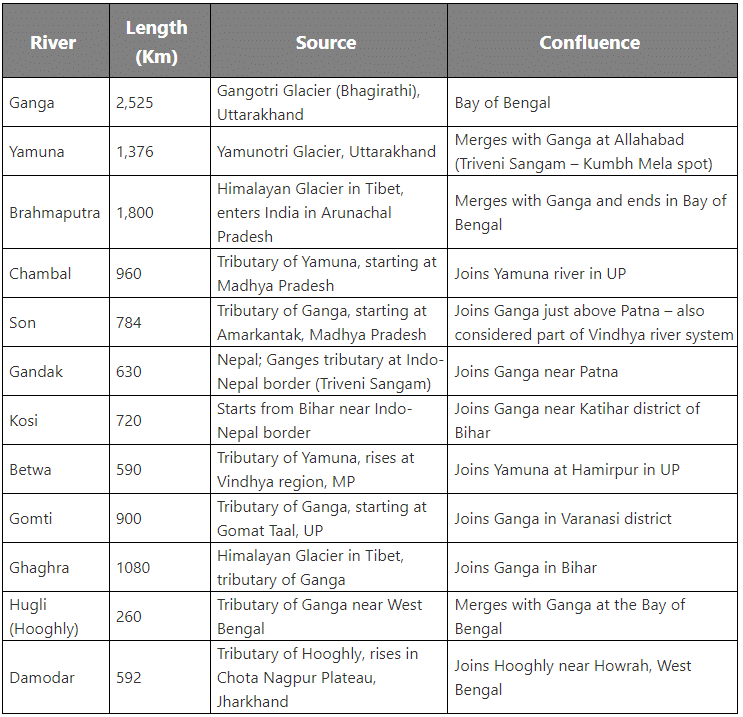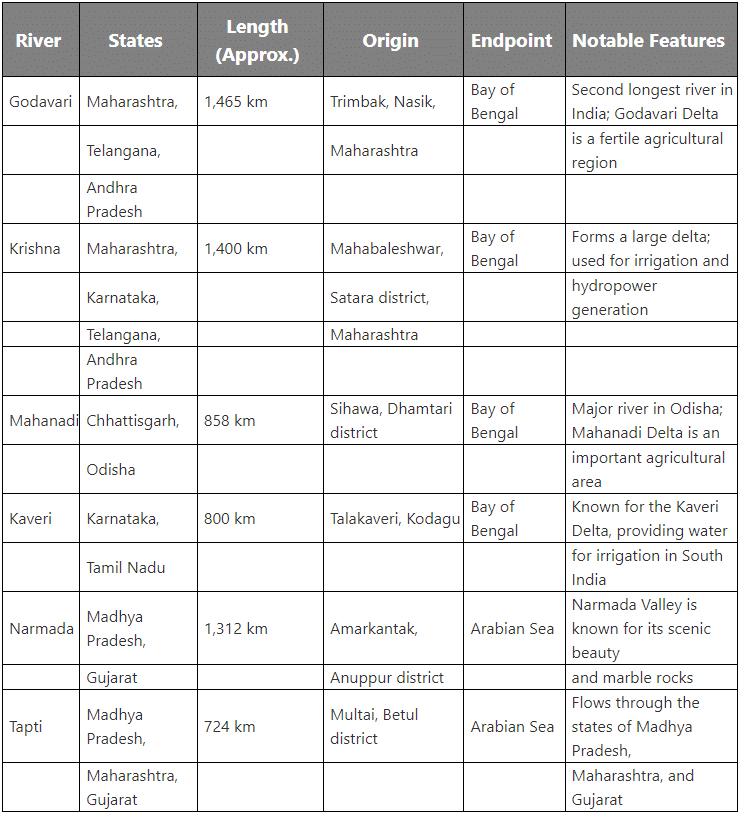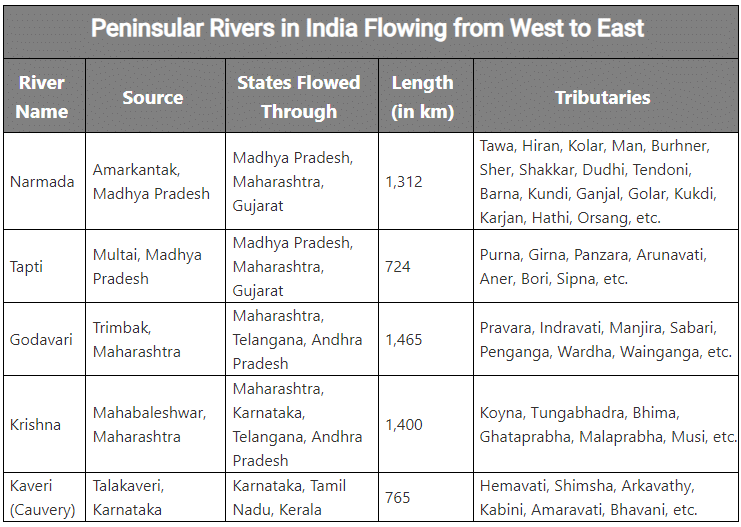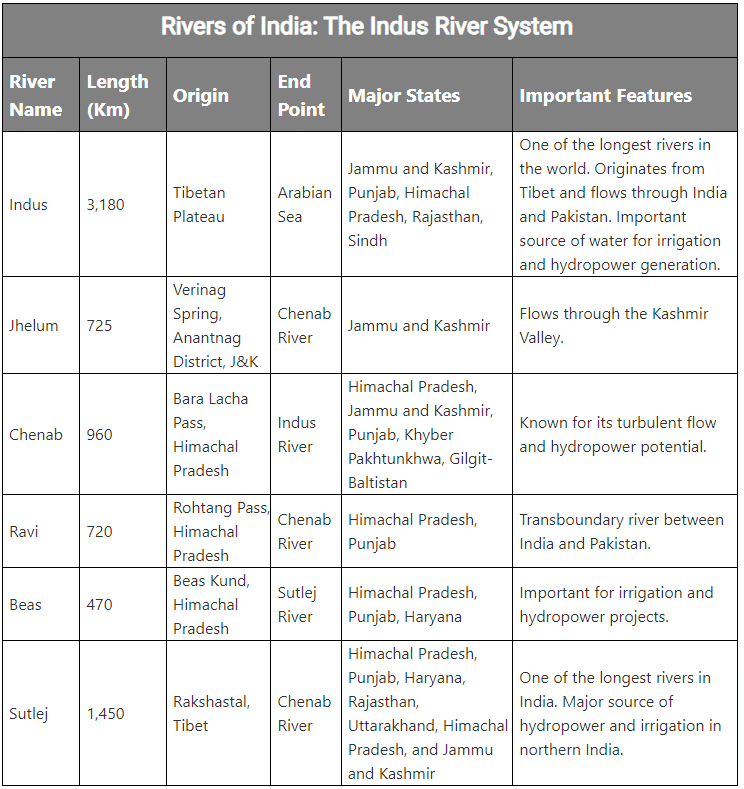Important Indian Rivers and their Origin | General Awareness - Bank Exams PDF Download
Longest Rivers in India
India boasts a vast network of rivers that nourish its fertile lands, support its ecosystems, and have played a key role in shaping its history, culture, and economy. In this article, we explore the longest rivers of India and the various river systems that contribute to the country's richness.Longest Rivers in India
Important Rivers in India
The rivers of India significantly affect the lives of millions, providing essential resources such as energy and water for irrigation. Major cities have often developed along riverbanks, benefitting from their resources. Additionally, these rivers hold immense religious significance in Hindu culture, being central to many myths and rituals.The Indian River System
India’s river system consists of seven major rivers:- Indus
- Brahmaputra
- Narmada
- Tapi
- Godavari
- Krishna
- Mahanadi
These rivers, along with their numerous tributaries, cover vast parts of the country. Most of the rivers flow into the Bay of Bengal, while some, especially in the western region, discharge into the Arabian Sea. In regions such as Ladakh, the northern Aravalli range, and the Thar Desert, there are instances of inland drainage where rivers do not flow into any sea or ocean.
Major Watersheds of India
India’s rivers originate from three major watersheds:The Himalayan and Karakoram mountain ranges
- These rivers are glacier-fed and flow throughout the year.
The Vindhya and Satpura mountain ranges and the Chotanagpur plateau in central India
- Rivers from these areas are mainly rain-fed and seasonal.
The Sahyadri or Western Ghats of Western India
- The rivers originating from the Western Ghats are short but flow with great force, especially during the monsoon.
These river systems collectively support the agricultural, economic, and cultural fabric of India, shaping its landscapes and societies over millennia
List of Rivers in India
Here’s a table listing some of the major rivers in India:
Important Rivers in India and Their Significance
- Ganges (Ganga): The Ganges is considered the holiest river in India. It originates from the Gangotri Glacier in the Himalayas and flows through key cities like Haridwar, Varanasi, and Kolkata before emptying into the Bay of Bengal. For Hindus, the Ganges holds immense religious and cultural significance, believed to cleanse sins and grant salvation. It is also vital for millions, providing drinking water, irrigation, and supporting livelihoods.
- Yamuna: The Yamuna, the largest tributary of the Ganges, originates from the Yamunotri Glacier in Uttarakhand. It flows through Himachal Pradesh, Haryana, and Uttar Pradesh before joining the Ganges at Allahabad (Prayagraj). The river is sacred in Hinduism, associated with Lord Krishna. It plays a key role in agriculture, providing water for millions dependent on its resources.
- Brahmaputra: Originating from Mansarovar Lake in the Himalayas, the Brahmaputra flows through Tibet, India, and Bangladesh. Entering India via Arunachal Pradesh, it passes through Assam and merges with the Ganges in Bangladesh. Known for its powerful currents and extensive basin, the Brahmaputra supports a rich ecosystem and is crucial for transportation and agriculture.
- Godavari: The Godavari, India's second-longest river, originates from the Western Ghats in Maharashtra. It flows through Telangana, Andhra Pradesh, and Odisha before reaching the Bay of Bengal. Known as the "Dakshina Ganga" (Ganges of the South), it has significant religious importance and is vital for irrigation, nourishing agricultural lands along its course.
- Krishna: Originating from the Mahabaleshwar hills in Maharashtra, the Krishna River flows through Maharashtra, Karnataka, and Andhra Pradesh before emptying into the Bay of Bengal. It is a key source of irrigation, supporting agriculture in the region. The Krishna River is also intertwined with several mythological tales, further enhancing its cultural significance.
- Narmada: The Narmada River, originating from the Amarkantak hills in Madhya Pradesh, is considered one of the seven sacred rivers in Hinduism. It flows through Gujarat, creating the scenic Marble Rocks gorge near Jabalpur. The Narmada is crucial for irrigation, hydroelectric power generation, and water supply for communities along its course.
- Kaveri (Cauvery): The Kaveri originates from the Brahmagiri hills in Karnataka and flows through Tamil Nadu before reaching the Bay of Bengal. Revered in both states, the Kaveri is essential for agriculture, providing irrigation to fertile regions along its banks. It plays a crucial role in sustaining the agricultural economy in southern India.
Rivers of India: Himalayan Rivers
The main Himalayan river systems in India are the Ganga, Indus, and Brahmaputra. As these rivers flow through the Himalayas, they have shaped vast basins over time. The down-cutting process during the uplift of the Himalayas has resulted in the creation of deep valleys with steep, rocky sides. These rivers, due to their strong erosional activity, transport large quantities of sand and silt from the upper reaches. Once they reach the plains, they form broad meanders and various depositional features such as flood plains, river cliffs, and levees.
Peninsular Rivers of India
The major rivers of Peninsular India include the Narmada, Tapi, Godavari, Krishna, Kaveri, and Mahanadi. These rivers flow through the southern region of the country. Unlike the Himalayan rivers, they traverse moderate valleys and have gentler slopes. Most of these rivers are seasonal, relying heavily on rainfall for their flow. The peninsular rivers have firm granite beds and carry minimal sand and silt, which reduces meandering and results in straight, horizontal courses. They are also a key source of hydroelectric power generation.- Peninsular Rivers of India: Mahanadi: The Mahanadi is an important river in east-central India, originating from the Sihava Mountains in Chhattisgarh. It primarily flows through Odisha and is noted for depositing the most silt of all rivers in the Indian subcontinent. Major cities like Sambalpur, Cuttack, and Banki are located along its course.
- Peninsular Rivers of India: Godavari: The Godavari River is the second-longest river in India after the Ganga. Originating from Triambakeshwar in Maharashtra, it flows through Maharashtra, Chhattisgarh, Madhya Pradesh, Odisha, Telangana, Andhra Pradesh, Karnataka, and Puducherry before emptying into the Bay of Bengal. The river is often called "Dakshina Ganga" due to its extensive course.
- Peninsular Rivers of India: Narmada: The Narmada, also known as Nerbudda, serves as the traditional boundary between North and South India. It stretches 1,289 kilometers (801 miles) and is a significant river in central India.
- Peninsular Rivers of India: Tapi: The Tapi River, with a length of about 724 km, is located in central India. It is one of the few rivers in peninsular India that flows from east to west, along with the Narmada and Mahi rivers.
- Peninsular Rivers of India: Krishna: The Krishna River, one of India’s longest rivers, extends approximately 1,300 km. It originates in Mahabaleshwar, Maharashtra, flows through Sangli, and eventually joins the Bay of Bengal at Hamasaladeevi in Andhra Pradesh.
- Peninsular Rivers of India: Kaveri: The Kaveri, also known as Cauvery or Kavery, is one of the major rivers in southern India and holds religious significance for Hindus. It is often referred to as "Dakshin Ganga" and flows into the Bay of Bengal.
Peninsular Rivers Flowing from East to West
In addition to the Tapi River, the Narmada River, and the Mahi River, there are no other major peninsular rivers that flow from east to west. Most of the peninsular rivers flow from west to east or south to north.
Peninsular Rivers in India Flowing from West to East
The table below contains the list of Peninsular Rivers of India Flowing from West to East:
1. Godavari River
2. Narmada River
3. Krishna River
4. Tapi River
Select the correct answer using the codes given below:
Rivers of India: The Indus River System
The Indus River originates from the northern Kailash range in Tibet, near Lake Manasarovar. It flows northwest through Tibet, entering India in Jammu and Kashmir, where it forms a dramatic gorge. Several tributaries, including the Zaskar, Shyok, Nubra, and Hunza rivers, join the Indus in this region. Within India, the main tributaries of the Indus are the Jhelum, Chenab, Ravi, Beas, and Sutlej rivers.- Jhelum River: The Jhelum originates from a spring near Verinag in southern Kashmir. It flows into Wular Lake before continuing through Baramula, carving a deep gorge in the Pir Panjal range between Baramula and Muzaffarabad.
- Chenab River: The Chenab is formed by the confluence of the Chandra and Bhaga rivers, which originate from opposite sides of the Bara Lacha Pass in Lahaul, Himachal Pradesh. In this region, it is also known as the Chandrabhaga.
- Ravi River: The Ravi begins near the Rohtang Pass in the Kangra Himalayas and flows northwest, creating a gorge through the Dhaola Dhar Mountains. After turning southwest near Dalhousie, it enters the Punjab plain at Madhopur.
- Beas River: The Beas starts at Beas Kund, near the Rohtang Pass, and flows through Manali and Kullu. The scenic Kullu Valley is formed along its course.
- Sutlej River: The Sutlej originates from Rakas Lake in Tibet, connected to Lake Manasarovar by a stream. It enters Himachal Pradesh at the Shipki Pass, where it merges with the Spiti River and flows northwestward.

Rivers of India: The Brahmaputra River
The Brahmaputra River begins its journey from Mansarovar Lake, which is also the source of the Indus and Sutlej rivers. Although most of its course lies outside India, the Brahmaputra is longer than the Indus. It flows eastward, parallel to the Himalayas, and after passing Namcha Barwa (7,757 m), it makes a dramatic U-turn to enter India through Arunachal Pradesh, where it is known as the Dihang. The river experiences a significant drop of about 5,500 meters as it flows into India. As it traverses through Arunachal Pradesh and Assam, it is joined by several tributaries, contributing to its vast water volume.Rivers in India and Their Features
Below is a table that lists notable rivers in India along with their key features:
Longest Rivers of India
India's extensive network of rivers plays a significant role in shaping the nation's geography, culture, and economy. Below is a closer look at some of the longest rivers in India and their significance:1. The Ganges (Ganga)
- Length: Approximately 2,525 kilometers
- States Flowing Through: Uttarakhand, Uttar Pradesh, Bihar, Jharkhand, West Bengal, and others
- Origin: Gangotri Glacier, Uttarakhand (Himalayas)
- Destination: Flows eastward into the Bay of Bengal via the Sundarbans delta in West Bengal
- Significance: The Ganges is the holiest river in Hinduism, revered for its religious importance and cultural impact. It is crucial for northern India's agriculture, drinking water supply, and industrial activities.
2. The Brahmaputra
- Length: Approximately 2,900 kilometers
- States Flowing Through: Arunachal Pradesh, Assam, and others
- Origin: Angsi Glacier, Tibet (known as Yarlung Tsangpo in Tibet)
- Destination: Merges with the Ganges in the Sundarbans delta
- Significance: The Brahmaputra, a transboundary river shared with China and Bangladesh, is essential for the northeastern states, supporting agriculture, navigation, and hydropower projects.
3. The Yamuna
- Length: Approximately 1,376 kilometers
- States Flowing Through: Uttarakhand, Uttar Pradesh, Haryana, and Delhi
- Origin: Yamunotri Glacier, Uttarakhand (Himalayas)
- Destination: Joins the Ganges at Allahabad (Prayagraj), Uttar Pradesh
- Significance: A sacred river in Hinduism, the Yamuna is vital for Delhi's water supply and for agricultural activities in nearby states. It holds immense religious importance and is considered the sister river of the Ganges.
4. The Godavari
- Length: Approximately 1,465 kilometers
- States Flowing Through: Maharashtra, Telangana, Andhra Pradesh, and others
- Origin: Brahmagiri Mountains, Maharashtra
- Destination: Flows into the Bay of Bengal near Rajahmundry, Andhra Pradesh
- Significance: Referred to as the "Dakshina Ganga" (Ganges of the South), the Godavari supports irrigation, agriculture, and industries. It is the second-longest river in India.
5. The Krishna
- Length: Approximately 1,400 kilometers
- States Flowing Through: Maharashtra, Karnataka, Telangana, Andhra Pradesh, and others
- Origin: Mahabaleshwar, Maharashtra
- Destination: Empties into the Bay of Bengal near Hamsaladeevi, Andhra Pradesh
- Significance: The Krishna River is critical for irrigation and hydropower in Karnataka and Andhra Pradesh. The river basin is home to major dams like Nagarjunasagar and is essential for supporting agriculture and water resources in southern India.
- These rivers form the backbone of India's water systems, sustaining its agriculture, industries, and population while holding deep religious and cultural significance.
Important Facts about Rivers of India for UPSC
Hindu Triveni Sangam
- Location: The confluence of the Ganga, Yamuna, and Saraswati rivers is known as the Triveni Sangam. This site, located in Prayagraj (Allahabad), is considered extremely sacred in Hindu mythology.
- Religious Significance: The Triveni Sangam is revered as a place where sins are washed away and one attains salvation. It is also the site for the Kumbh Mela, one of the largest religious gatherings in the world.
- Mythical Saraswati: The Saraswati River, believed to have dried up, is thought to meet the Ganga and Yamuna underground at this confluence.
Saraswati River
- Existence: While the Saraswati was considered mythical, recent geological and satellite studies suggest that it may have been a real river that flowed through northwestern India.
- Underground Flow: It is believed that the Saraswati now flows underground, and its confluence with the Ganga and Yamuna might have happened in ancient times at the site of the Triveni Sangam.
- Cultural Impact: The river is often mentioned in the Vedas and ancient texts as a symbol of knowledge and purity.
Meghna River
- Location: The Meghna is a major river in Bangladesh but is also part of the greater Brahmaputra River system in India.
- Significance: After originating in India, it flows through Bangladesh, where it plays a vital role in the region’s hydrology. The Meghna is crucial for agriculture, transportation, and fishing.
- Bay of Bengal: It eventually merges with the Ganges-Brahmaputra river system before emptying into the Bay of Bengal, influencing the deltaic regions.
These facts are important for UPSC aspirants, as they highlight key geographical and cultural aspects of India's river systems, their significance, and their historical connections to ancient Indian civilization.
|
365 videos|701 docs|149 tests
|
FAQs on Important Indian Rivers and their Origin - General Awareness - Bank Exams
| 1. What are the longest rivers in India and their lengths? |  |
| 2. What is the significance of the Ganges River in India? |  |
| 3. What are the main rivers of the Himalayan region in India? |  |
| 4. How do the peninsular rivers of India differ from the Himalayan rivers? |  |
| 5. Which rivers in India flow from east to west, and what is their significance? |  |






















